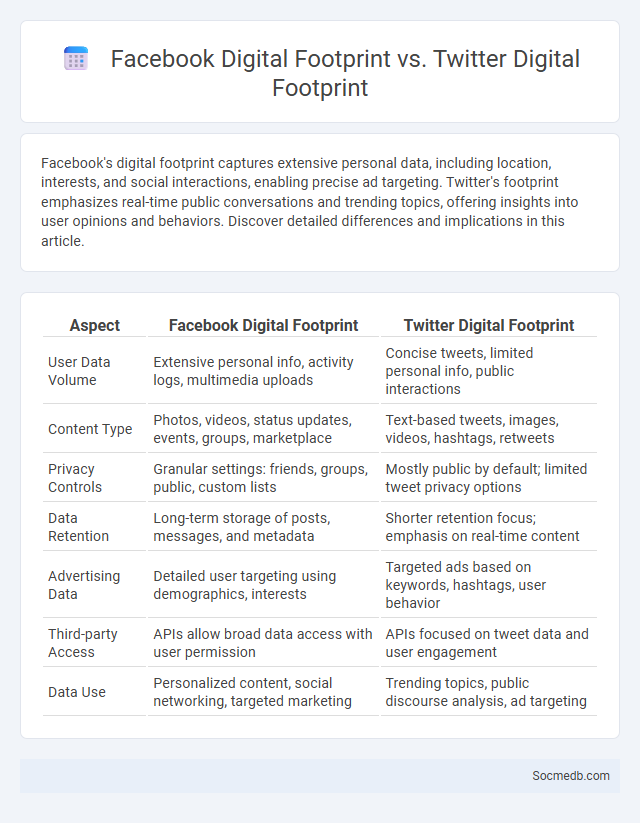
Photo illustration: Facebook Digital Footprint vs Twitter Digital Footprint
Facebook's digital footprint captures extensive personal data, including location, interests, and social interactions, enabling precise ad targeting. Twitter's footprint emphasizes real-time public conversations and trending topics, offering insights into user opinions and behaviors. Discover detailed differences and implications in this article.
Table of Comparison
| Aspect | Facebook Digital Footprint | Twitter Digital Footprint |
|---|---|---|
| User Data Volume | Extensive personal info, activity logs, multimedia uploads | Concise tweets, limited personal info, public interactions |
| Content Type | Photos, videos, status updates, events, groups, marketplace | Text-based tweets, images, videos, hashtags, retweets |
| Privacy Controls | Granular settings: friends, groups, public, custom lists | Mostly public by default; limited tweet privacy options |
| Data Retention | Long-term storage of posts, messages, and metadata | Shorter retention focus; emphasis on real-time content |
| Advertising Data | Detailed user targeting using demographics, interests | Targeted ads based on keywords, hashtags, user behavior |
| Third-party Access | APIs allow broad data access with user permission | APIs focused on tweet data and user engagement |
| Data Use | Personalized content, social networking, targeted marketing | Trending topics, public discourse analysis, ad targeting |
Understanding Digital Footprints: A Semantic Overview
Your digital footprint encompasses all the data and interactions you leave on social media platforms, including posts, comments, likes, and shared content. Understanding these footprints involves recognizing how algorithms track and analyze your behavior to influence your online experience and privacy. Managing your digital footprint can enhance your online reputation and protect your personal information from misuse.
Facebook Digital Footprint: Key Characteristics
Facebook's digital footprint is characterized by extensive user data collection, including personal information, location, interactions, and browsing behaviors, enabling highly targeted advertising. The platform tracks user activity across devices and third-party websites through cookies and plugins, creating comprehensive behavioral profiles. Privacy settings and content sharing openly contribute to the visibility and persistence of user data within the social media ecosystem.
Twitter Digital Footprint: Unique Features
Twitter's digital footprint is shaped by its real-time updates, hashtag culture, and retweet functionality, making it distinct in the social media landscape. Your interactions on Twitter create a publicly accessible history of concise, timely conversations that drive trends and influence public opinion globally. The platform's character limit encourages brevity, fostering rapid information sharing and unique digital identity creation.
Comparing Facebook vs Twitter Digital Footprints
Facebook's digital footprint centers on detailed personal profiles, extensive multimedia sharing, and network connections emphasizing real-life relationships, while Twitter's footprint revolves around concise public updates, trending hashtags, and rapid information dissemination. Your online presence on Facebook tends to be more permanent and richly detailed, enabling targeted advertising and data analytics based on in-depth user interactions. Twitter's footprint is more transient and public, facilitating real-time conversation tracking and broad audience engagement through succinct messages.
Data Sharing and Privacy on Facebook
Facebook's data sharing practices involve collecting extensive personal information from your profile, activity, and interactions to tailor ads and improve user experience. Privacy settings allow you to control visibility and limit data access by third-party apps, but default configurations often favor broader data sharing. Understanding Facebook's permissions and reviewing your privacy options regularly is essential to safeguard your personal information from unauthorized exposure.
Data Sharing and Privacy on Twitter
Twitter's data sharing policies directly impact your privacy by controlling how personal information is collected, used, and shared with third-party partners. Understanding Twitter's settings for data sharing, such as personalized ads and location tracking, helps you manage and secure your account information effectively. Protecting your data on Twitter involves regularly reviewing privacy controls and limiting permissions to reduce exposure to data breaches and unauthorized access.
Public vs Private Content: Platform Differences
Social media platforms differ significantly in their approach to public versus private content, with Facebook offering granular privacy controls enabling users to share posts exclusively with friends or specific groups. Twitter primarily emphasizes public content, allowing users to broadcast messages broadly, but also includes options for protected accounts to restrict followers. LinkedIn combines public professional profiles with customizable privacy settings, allowing users to control who can see their activity and contact information.
Long-Term Impact of Social Media Footprints
Social media footprints create a lasting digital record that can influence personal and professional opportunities years after content is posted. Persistent data trails affect reputation management, with employers and institutions frequently reviewing online activity during background checks. Understanding the long-term implications encourages mindful sharing and proactive privacy management to safeguard future prospects.
Managing and Minimizing Your Digital Footprint
Managing and minimizing your digital footprint involves regularly auditing privacy settings on social media platforms such as Facebook, Instagram, and Twitter to limit data exposure. Employing tools like privacy checkups and clearing search histories can reduce the amount of personal information accessible online. You should also be cautious about the content you share and aware of data tracking practices to maintain greater control over your digital identity.
Best Practices for Digital Footprint Security
Protecting Your digital footprint requires regularly updating privacy settings on all social media platforms to limit data exposure. Use strong, unique passwords combined with two-factor authentication to safeguard accounts from unauthorized access. Be mindful about the type and amount of personal information you share online, as oversharing can increase vulnerability to identity theft and cyberattacks.
 socmedb.com
socmedb.com